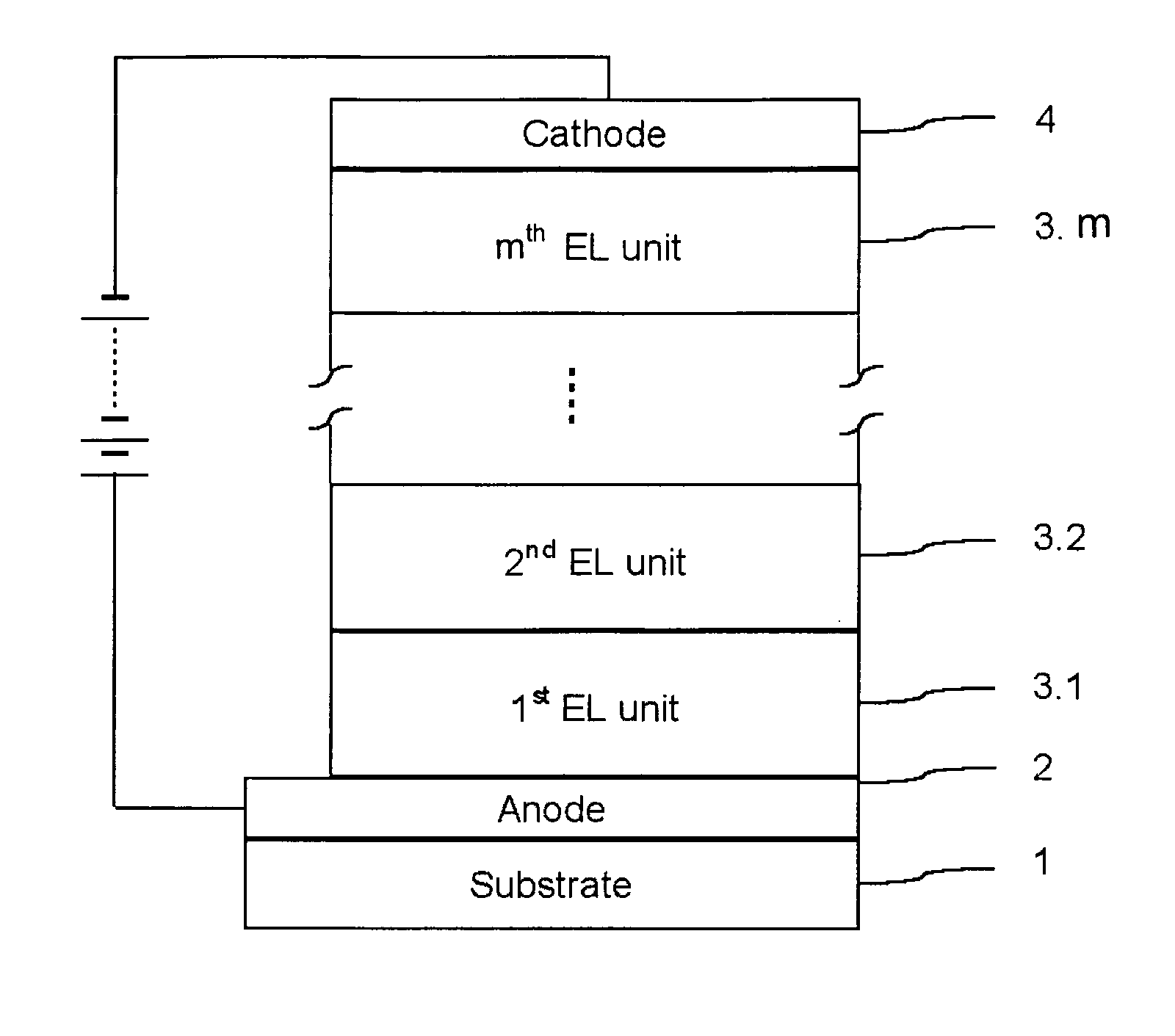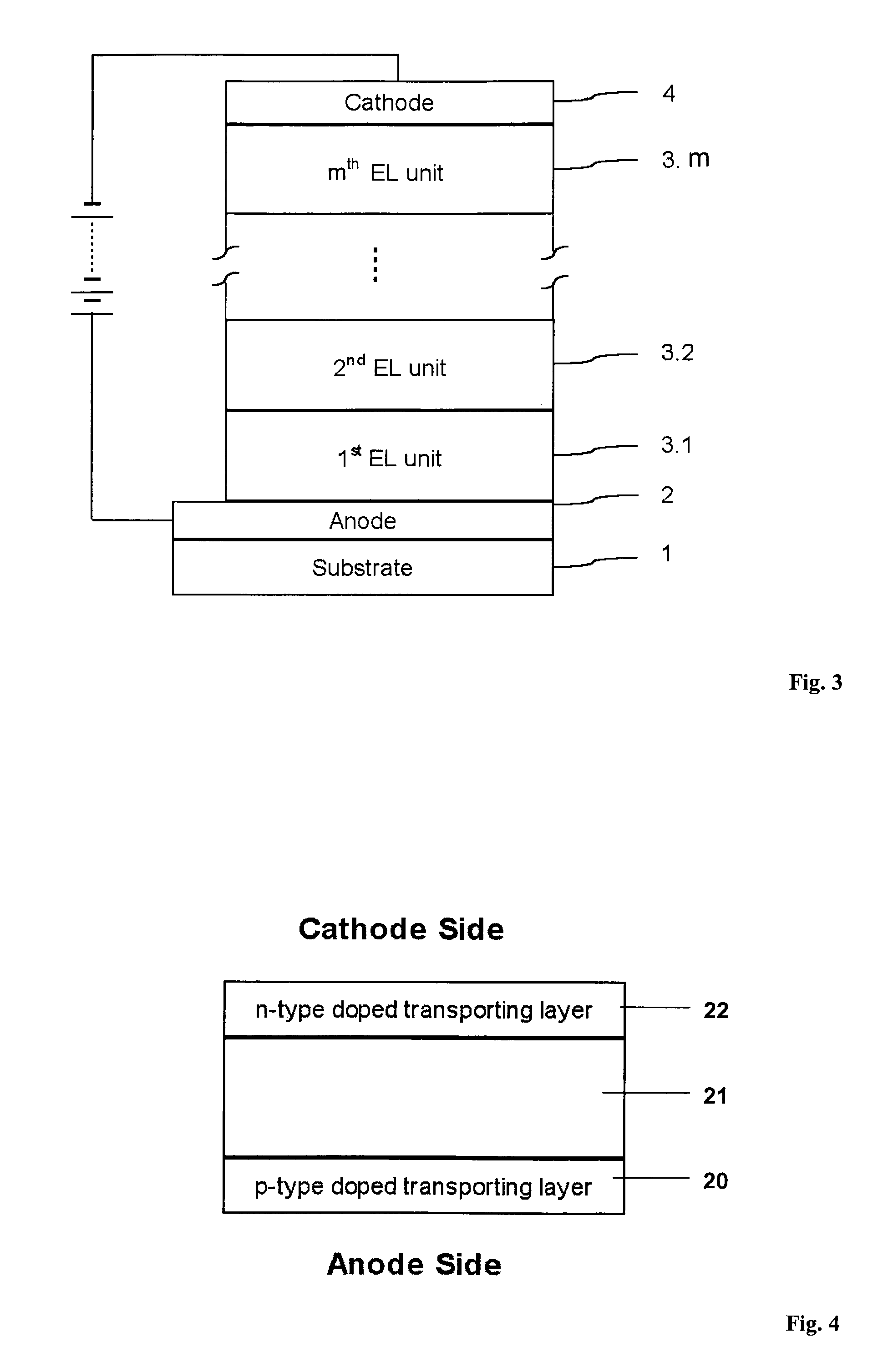Electronic device with a layer structure of organic layers
a technology of organic layers and electroluminescent devices, which is applied in the direction of discharge tubes/lamp details, discharge tubes luminescent screens, electric discharge lamps, etc., can solve the problems of reduced operating voltage of electroluminescent devices, feature extremely low operating voltage, and additional costs, so as to reduce the tendency of degradation, and tailor the interface stability
- Summary
- Abstract
- Description
- Claims
- Application Information
AI Technical Summary
Benefits of technology
Problems solved by technology
Method used
Image
Examples
example 1
Conventional
[0099]According to Example 1a structure for a conventional light emitting device is provided as follows:[0100]1.1 50 nm 2,2′,7,7′-Tetrakis-(N,N-di-methylphenylamino)-9,9′-spirobifluorene doped with 2-(6-Dicyanomethylene-1,3,4,5,7,8-hexafluoro-6H-naphtalen-2-ylidene)-malononitrile (p-type doped hole-transport layer);[0101]1.2 10 nm NPB (interlayer);[0102]1.3 20 nm Spiro-DPVBI;[0103]1.4 10 nm Bphen;[0104]1.5 45 nm Bphen doped with Cs (n-type doped electron-transport layer);[0105]1.6 50 nm 2,2′,7,7′-Tetrakis-(N,N-di-methylphenylamino)-9,9′-spirobifluorene doped with 2-(6-Dicyanomethylene-1,3,4,5,7,8-hexafluoro-6H-naphtalen-2-ylidene)-malononitrile (p-type doped hole-transport layer);[0106]1.7 10 nm NPB (interlayer);[0107]1.8 20 nm Spiro-DPVBI;[0108]1.9 10 nm Bphen;[0109]1.10 20 nm Bphen doped with Cs (n-type doped electron-transport layer);[0110]1.11 100 nm Aluminum (reflective cathode).
[0111]This is a blue stacked PIN-OLED where layers 1.1 to 1.5 constitute a first PIN-OLE...
example 2
[0114]According to Example 2a structure for a light emitting device is provided as follows:[0115]2.1 50 nm 2,2′,7,7′-Tetrakis-(N,N-di-methylphenylamino)-9,9′-spirobifluorene doped with 4 mole % 2-(6-Dicyanomethylene-1,3,4,5,7,8-hexafluoro-6H-naphtalen-2-ylidene)-malononitrile as p-type doped hole-transport layer;[0116]2.2 10 nm NPB as interlayer,[0117]2.3 20 nm Spiro-DPVBI;[0118]2.4 10 nm 2,4,7,9-Tetraphenyl-1,10-phenanthroline;[0119]2.5 45 nm 2,4,7,9-Tetraphenyl-1,10-phenanthroline doped with 5 mole % Tetrakis(1,3,4,6,7,8-hexahydro-2H-pyrimido[1,2-a]pyrimidinato)ditungsten (II) as n-type doped electron-transport layer;[0120]2.6 50 nm 2,2′,7,7′-Tetrakis-(N,N-di-methylphenylamino)-9,9′-spirobifluorene doped with 4 mole % 2-(6-Dicyanomethylene-1,3,4,5,7,8-hexafluoro-6H-naphtalen-2-ylidene)-malononitrile as p-type doped hole-transport layer;[0121]2.7 10 nm NPB as interlayer,[0122]2.8 20 nm Spiro-DPVBI;[0123]2.9 10 nm 2,4,7,9-Tetraphenyl-1,10-phenanthroline;[0124]2.10 20 nm 2,4,7,9-Tetr...
example 3
[0128]According to Example 3a structure for a light emitting device is provided as follows:[0129]3.1 75 nm 2,2′,7,7′-Tetrakis-(N,N-di-methylphenylamino)-9,9′-spirobifluorene doped with 4 mole % 2-(6-Dicyanomethylene-1,3,4,5,7,8-hexafluoro-6H-naphtalen-2-ylidene)-malononitrile (p-type doped hole-transport layer);[0130]3.2 10 nm NPB (interlayer);[0131]3.3 20 nm NPB doped with Iridium (III) bis(2-methyldibenzo[f,h]quinoxaline) (acetylacetonate);[0132]3.4 10 nm 2,4,7,9-Tetraphenyl-1,10-phenanthroline;[0133]3.5 60 nm 2,4,7,9-Tetraphenyl-1,10-phenanthroline doped with 2 mole % Tetrakis(1,3,4,6,7,8-hexahydro-2H-pyrimido[1,2-a]pyrimidinato)ditungsten (II) (n-type doped electron-transport layer);[0134]3.6 45 nm 2,2′,7,7′-Tetrakis-(N,N-di-methylphenylamino)-9,9′-spirobifluorene doped with 4 mole % 2-(6-Dicyanomethylene-1,3,4,5,7,8-hexafluoro-6H-naphtalen-2-ylidene)-malononitrile (p-type doped hole-transport layer);[0135]3.7 10 nm NPB (interlayer);[0136]3.8 20 nm NPB doped with Iridium (III) b...
PUM
 Login to View More
Login to View More Abstract
Description
Claims
Application Information
 Login to View More
Login to View More - R&D
- Intellectual Property
- Life Sciences
- Materials
- Tech Scout
- Unparalleled Data Quality
- Higher Quality Content
- 60% Fewer Hallucinations
Browse by: Latest US Patents, China's latest patents, Technical Efficacy Thesaurus, Application Domain, Technology Topic, Popular Technical Reports.
© 2025 PatSnap. All rights reserved.Legal|Privacy policy|Modern Slavery Act Transparency Statement|Sitemap|About US| Contact US: help@patsnap.com



